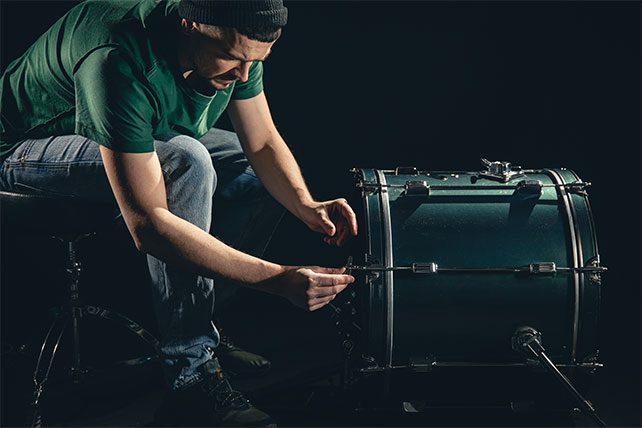Resonant heads are as thin as single plys, 7-10 mil, but can be as thin as 2-5 mil for snare heads. The thicker heads offer more sustain and deeper tone than thinner heads with less sustain and brighter tone.
Drum heads are like guitar strings; over time they wear out, sound worse and eventually break. The lifespan is determined primarily by usage; how hard and how often they’re hit. Over time, they’ll lose their brightness and this is where things become hard to judge.
Some drummers replace heads every six months while others go every three years and others go much longer. Judge based on the brightness and what works in your room. If the tone is great but the drum heads are a few years old, keep using them. Also, if the drums are too bright in your room, look to switching to coated heads or double ply.
Know that heads wear out at different rates so you’ll likely replace a snare drum head several times before replacing a small tom head. Watch for deep pitting on the kick drum from the beater. Finally, keep spares on hand for obvious reasons.
2. Tune
Drums go out of tune for a number of reasons including age and temperature changes. It’s best to keep drums in a fixed temperature and humidity environment. When that doesn’t happen, such as when the heating or AC is turned on only for the weekend, the wooden shell will expand or contract causing detuning of the drums.
I’ve seen drums detune during seasons of heavy Midwest humidity. In some cases, after the room AC is on long enough, the drums will go back in tune—maybe not perfectly in tune, but close.
A drum sounds best (and performs best) when the head has even tension across the head. Therefore, have a skilled tuner tune your drums or do it yourself using something like the Overtone Labs Tune-Bot Digital Drum Tuner. You might have a drummer that’s great at drum tuning.
3. Patch
Place a kick drum patch where the beater contacts the head. The patch will absorb the impact of the beater without negatively affecting the sound. The patches can also increase clarity and attack.
Aquarian Drum Heads makes the kick-PATCH, a large circular patch for temporarily repairing minimally broken kick drum heads—better than a gaff tape fix.
4. Review Microphone Placement
OK, this isn’t exactly drum head repair, but it’s an important step to ensure the drums sound good at the source.
I take this step whenever I’m mixing. With a nine-microphone setup including a Yamaha SubKick microphone, it’s important that each one is positioned correctly. Overheads should be positioned at an equal height, snare and tom microphones should be an inch from the drum head, angled slightly. It’s also important to consider the location on the perimeter of the drum so cymbals are in the null area of the mic’s polar pattern.
Also, have a fixed microphone placement that’s the same for every weekend. You might like overheads at a certain height and someone else likes them closer. Establish a standard setup. This helps toward creating a general overall mix that’s consistent from week to week.
Don’t find yourself in a situation like I did. Stay on top of drum kit maintenance by running through the above steps every few months. Depending on your environment, tuning might need to occur on a regular basis.
Oh, a funny little note to add about my busted kick drum. Anthony replaced the tom heads a week prior but thought the kick drum head was OK. So it goes with drum head repair.
The Next Step
Check out this article on mixing the snare drum—it’s got everything from EQ work to microphone selection: The Art of Snare Mixing
This article originally on drum head repair appeared here.

